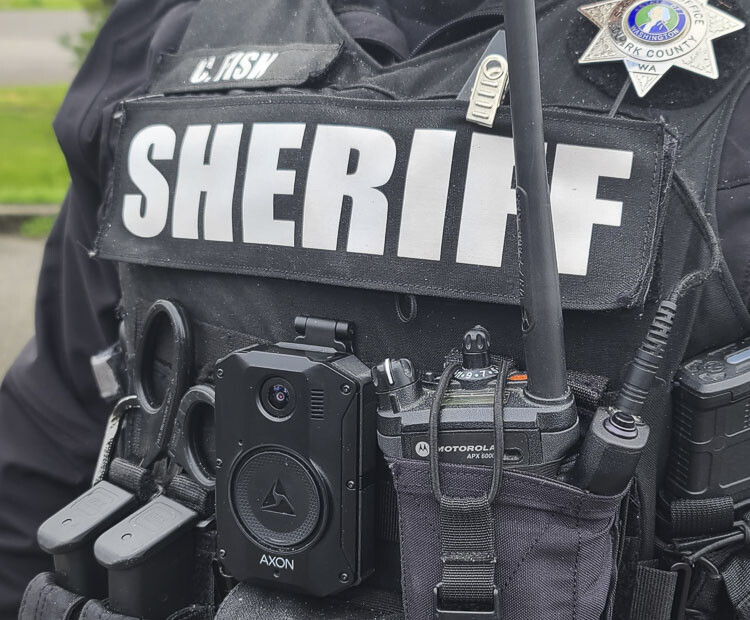
Clark County Sheriff John Horch said videos often show his deputies using proper de-escalation tactics during incidents, and he is grateful for video evidence to be transparent with the public, whether the video is ‘good or bad’
Paul Valencia
ClarkCountyToday.com
Recently, Clark County Sheriff John Horch sat down with Clark County Today to discuss a number of subjects concerning the Clark County Sheriff’s Office: Staffing issues, department morale, the office’s relationship with federal agencies, the implementation of body-worn cameras, de-escalation training in law enforcement, and more.
Clark County Today is posting several stories in his series.
In the first post, the sheriff sounded the alarm on staffing shortages.
In the second post, the sheriff detailed his office’s policy regarding federal law enforcement, such as immigration.
In this post, he talks about the implementation of body-worn cameras, and how they help the public to better understand law enforcement and help train his deputies on tactics, such as de-escalation tools.
“… if it shows good or bad, I’m going to put it out there. I want to be transparent so people can see.”
The Clark County Sheriff’s Office began testing its body-worn cameras with a few deputies in the spring of 2023. By the fall, the program expanded beyond the testing phase. And by January of 2024, all deputies and their vehicles had been equipped with Axon cameras.
“I think they’ve been great. I’ve only heard positive comments on them,” Horch said.
The cameras are tools that the sheriff’s office uses to educate the public as well as train deputies on proper procedures. That would include de-escalation tactics.
“We want to show on body cameras how much de-escalation that we do,” Horch said.
For major incidents, such as shootings, Horch has vowed to release the videos to the public, usually within a couple of weeks.
“I own that. I decide when to put it out,” Horch said. “I told the public … if it shows good or bad, I’m going to put it out there. I want to be transparent so people can see.”

Three major incidents from 2024 have been released. They can be found on the sheriff’s page on the Clark County government’s website: https://clark.wa.gov/sheriff/body-worn-camera-bwc-program
There have been a handful of other major incidents caught on video involving nearby law enforcement agencies, such as the Vancouver Police Department, that also have gone public. Horch appreciates that his colleagues are on board with releasing pertinent videos.
“There hasn’t been one question about body-worn cameras,” Horch said regarding the public release. “We put them out there. ‘This is what we have.’”
Horch is particularly impressed with the failsafes associated with the program. There might be times when a deputy forgets to turn on the camera. But if emergency lights on a vehicle are turned on, the body worn cameras as well as the cameras on the vehicle are automatically activated. Same thing if a deputy draws a weapon. Also, when a camera is turned on, any camera worn by a colleague within 25 yards is also activated.
When the cameras are activated, the previous 30 seconds are also saved, in an effort to provide more context to how a situation escalated.
Horch called that technology phenomenal.
The videos can also show administrators how their deputies are performing their duties. No, there are no “fishing” expeditions, Horch said. Supervisors are not going over videos every day to find out if a deputy did something wrong. But if a complaint has been lodged against a deputy, there is video to observe.
Horch said he has seen a video that showed his deputy was, in fact, rude during a contact made with a resident. A written reprimand was necessary.
The videos also can exonerate a deputy.
“We have some where the deputy did everything correct,” Horch said. “In fact, the person (making the complaint) was rude.”
That is why, Horch said, most people in law enforcement appreciate the cameras.
“I would say 99 percent of officers would say, ‘Record me all day long. I don’t have any issues whatsoever.’”
That is the philosophy the sheriff wants to hear from his deputies.
Horch is also optimistic that most videos will show his deputies performing their duties to the best of their abilities, while using tactics to deescalate a situation.
“We’ve been doing de-escalation since the time I started,” said Horch, who was hired by the Clark County Sheriff’s Office in 1989. “It was just never called that.”
Now, there is specific training written in law. Law enforcement officers must have less-lethal tools with them. They all take mandatory patrol tactics training, which includes a de-escalation class.
Horch said there are many steps of de-escalation. The first could be just the presence of a deputy. Law enforcement shows up, and perhaps cooler heads prevail in an intense situation. Or maybe more conversation can ease tensions.
But Horch said videos provided by body-worn cameras have been instrumental in showing the public that sometimes a situation goes from zero to 10.
“Things can change very quickly,” Horch said.
Bottom line, Horch is grateful for the technology and his team’s implementation of body-worn cameras. He said the cameras provide an accurate account of emergency situations, bring transparency to the public, and help law enforcement improve its strategies.
Also read:
- POLL: Should Washington Raise the 1% Cap on Property Tax Increases?Clark County Today’s weekly poll asks whether Washington lawmakers should raise the current 1% cap on annual property tax increases.
- The Study of Sports Podcast, April 10, 2025: Some spring sports talk, including the challenges of hosting large track and field meets, plus an epic Mariners fandom storyIn the latest episode of The Study of Sports Podcast, Paul Valencia is joined by Cale Piland and Tony Liberatore for a mix of local sports coverage and one unforgettable Mariners fandom story.
- Public memorial for former Vancouver Mayor Royce PollardA public memorial will be held April 11 in Vancouver to honor former Mayor Royce Pollard and his lasting contributions to the city’s growth and development.
- Letter: The more you knowCamas resident Anna Miller criticizes a recent remark by Rep. Jasmine Crockett as racist and demeaning, and outlines Republican contributions to civil rights history in her letter to the editor.
- Letter: City vehicles speeding on the highwaysVancouver resident Peter Bracchi raises concerns about excessive speeding by city-owned vehicles, based on GPS data received through a FOIA request.
- Can $10 tolls be coming to the Interstate Bridge?Rep. John Ley examines a proposed Washington House bill that would double borrowing for the Interstate Bridge Replacement and potentially lead to high tolls affecting Southwest Washington drivers.
- Senate Republicans: WA property taxes will skyrocket under bill to remove annual capSenate Republicans are opposing Senate Bill 5798, warning it could sharply increase Washington property taxes by removing the long-standing 1% cap.











